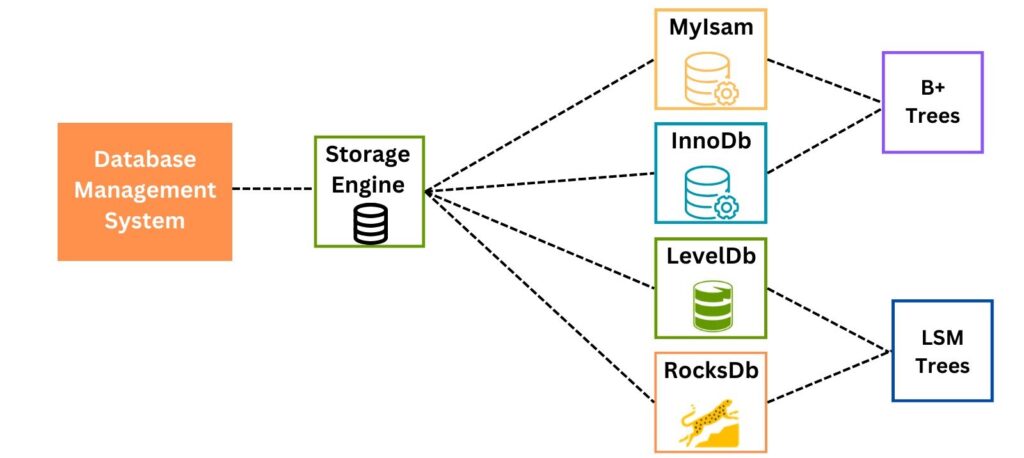In the intricate realm of Database Management Systems (DBMS), the storage engine takes center stage, wielding a significant influence on the overall performance of a database. This article aims to unravel the complexities surrounding storage engines, shedding light on their functionalities, impact on CRUD operations, and the pivotal role they play in shaping database efficiency.
1. The Heart of DBMS: Storage Engines
At its core, a storage engine is the powerhouse of a DBMS, executing Create, Read, Update, and Delete (CRUD) operations on the disk. It goes beyond mere execution, delving into the realm of indexing by employing specialized data structures. Two prominent types of data structures stand out in this landscape: B-trees and Log-Structured Merge (LSM) trees.
2. B-trees vs. LSM Trees: The Structural Dilemma
The choice between B-trees and LSM trees is pivotal, impacting the speed at which a database operates. B-trees excel in read performance, making them suitable for scenarios where quick data retrieval is paramount. On the flip side, LSM trees shine in write-heavy operations, prioritizing efficient write processes.
3. The Art of Tradeoffs in Storage Engine Selection
There is no one-size-fits-all solution when it comes to storage engines. The selection depends on the tradeoffs an organization is willing to make. While B-trees optimize read performance, LSM trees cater to write-centric operations. The key lies in understanding the specific requirements of your database workload.
4. Modularity and Customization in DBMS
The modular nature of a DBMS allows for flexibility in storage engine usage. Organizations can leverage a current engine to build a custom DBMS tailored to their unique needs. Some systems even permit the seamless switching between storage engines, offering adaptability to evolving requirements.
5. Real-World Examples: MySQL, MongoDB, and Beyond
In the real-world application of storage engines, platforms like MySQL and MongoDB exemplify the adaptability and interchangeability of these critical components. These systems provide built-in mechanisms to transition between storage engines, allowing organizations to fine-tune their databases.
6. MyISAM vs. InnoDB: A B+ Tree Dilemma
The rivalry between MyISAM and InnoDB, two well-known storage systems employing B+ trees, showcases the nuances of storage engine choices. InnoDB’s ascendancy over MyISAM in 2009 as MySQL’s default storage engine underscores the importance of considering factors like concurrent writing, transaction handling, and foreign key support.
7. LevelDB vs. RocksDB: Embracing LSM Trees
LevelDB and RocksDB, both leveraging LSM trees, offer an alternative approach to storage. Originating from Google, LevelDB introduces features like forward and backward iteration, batching writes, and a compression library. Facebook’s RocksDB, a LevelDB fork, adds further enhancements, including multi-core support, transactions, bloom filters, and geospatial capabilities.
8. Navigating the Storage Landscape: Insights and Considerations
As organizations navigate the intricate landscape of storage engines, gaining insights into the strengths and considerations of B-trees and LSM trees becomes paramount. Whether optimizing for read-heavy or write-intensive workloads, understanding the intricacies of storage engines is the key to unlocking enhanced database performance.

Read About: Relational Database Management Systems : Unraveling the Core of Data Management.
Frequently Asked Questions about Storage Engines in Databases
- What is a storage engine in a database?
- A storage engine is a fundamental component of a database management system responsible for executing CRUD operations and implementing indexing using specialized data structures.
- What are the main types of data structures used by storage engines?
- The main types of data structures used by storage engines are B-trees and Log-Structured Merge (LSM) trees.
- How does the choice of data structure impact database performance?
- The choice of data structure, whether B-trees or LSM trees, significantly impacts database performance, influencing factors such as read and write operations.
- What is the tradeoff between B-trees and LSM trees?
- The tradeoff between B-trees and LSM trees revolves around read and write performance. B-trees excel in read-heavy scenarios, while LSM trees are optimized for write-centric operations.
- Is there a one-size-fits-all solution for storage engine selection?
- No, there is no one-size-fits-all solution for storage engine selection. The choice depends on the specific tradeoffs an organization is willing to make based on its unique database workload.
- How modular is a Database Management System (DBMS) regarding storage engines?
- A DBMS is modular, allowing for flexibility in storage engine usage. Organizations can use existing engines to build custom DBMS or switch between storage engines seamlessly.
- Can storage engines be switched in well-known database systems like MySQL and MongoDB?
- Yes, platforms like MySQL and MongoDB support the switching of storage engines. These systems provide built-in mechanisms to transition between different storage engines.
- What are some real-world examples of storage systems using B+ trees and LSM trees?
- MyISAM and InnoDB are examples of storage systems using B+ trees, whereas LevelDB and RocksDB leverage LSM trees. These examples showcase the diversity in storage engine choices.
- How do storage engines impact the overall performance of a relational database?
- Storage engines play a crucial role in shaping the overall performance of a relational database, influencing factors such as transaction handling, concurrent writing, and support for features like foreign keys.
- What are the key considerations when navigating the storage landscape of databases?
- Navigating the storage landscape requires understanding the strengths and considerations of different storage engines. Considerations include workload optimization for read-heavy or write-intensive scenarios.